Invasive Trees Are an Issue in Monroe County’s Natural Areas
We often use this platform to discuss invasive plant species such as Asian bush honeysuckle. Rarely do we broach the subject of invasive trees, but in this article we will address two invasive trees—one that is a local favorite (Mimosa) and another that you will not find at your favorite nursery (Tree-of Heaven).
Mimosa (Albizia julibrissin), also known as silk tree, is Eurasian in origin. It was imported to our country in the mid-eighteenth century as an ornamental that remains popular because of its showy, fragrant flowers, finely-cut foliage and ease of cultivation. It can be seen in many yards throughout Monroe, Randolph and St. Clair counties.
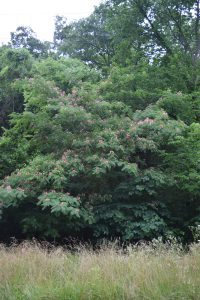
A member of the Pea family, Mimosa can grow 10 to 50 feet in height. Leaflets of the compound leaves will curl and close like pages in a book when handled. Numerous showy, powder-puff shaped flowers appear from June through August, and are followed by flat pods about six inches long that contain the large flat seeds. The seeds can persist for many years, and though the majority are dropped near the parent plant, seeds are eaten and passed on by animals and can be washed into streams and quickly disbursed to new areas.
Mimosa grows and flowers best in full sun, but will grow in a variety of conditions. It spreads quickly to form dense colonies in disturbed areas. Mimosa is often found along roadsides and near areas where it has escaped from cultivation, but has also been found deep in the forests of the bluffs. It can become a serious pest along streams where seeds are easily spread. Mimosa can reproduce both by seed and vegetatively; top-killed trees quickly re-sprout and re-grow. The dense stands of wild-growing Mimosa trees quickly out-compete native trees and shrubs and shade-out native wildflowers and grasses.
For information on control and management, please visit Clifftop’s website: http://www.clifftopalliance.org/2011/09/mimosa/.

Tree-of-Heaven (Ailanthus altissima)is known by a number of names: stinking sumac, Chinese sumac, stink tree, or, as some in the conservation community like to call it, Tree-from-Hell. It was brought to the eastern United States in the late 1700s from China as a horticultural specimen and shade tree. Ease of establishment, rapid growth and absence of insect or disease problems resulted in Tree-of-Heaven being extensively planted in U.S. towns and cities during the 1800s. It has likely not been purposefully planted for at least a century, but now occurs nearly throughout the U.S and threatens to overwhelm natural areas, agricultural fields and roadsides in many states due to its ability to produce an overly abundant amount of seeds, reproduction through roots and a chemical that can prevent or kill other plants near it.
Francie Nolan, the protagonist in A Tree Grows in Brooklyn, is said to “struggle against all odds to survive and thrive like the Tree-of-Heaven that grows out of cement or through cellar gratings” in a quote from Emilie Coulter, Amazon.com, at the online book reference website “Fantastic Fiction.”
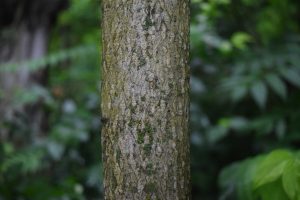
Tree-of-Heaven is a rapidly growing deciduous tree that can reach 80 feet or more in height. It has smooth stems with pale gray bark, light brown twigs, and large compound leaves — up to three feet in length with as many as 25 leaflets. Small yellow-green flowers form in dense clusters near the ends of upper stems. Male and female flowers usually occur on separate trees; however, both bisexual and uni-sexual flowers have been reported on individual Trees-of-Heaven. Flowers are followed by pink to tan colored winged seed-containing fruits (samaras). All parts of the tree, especially the flowers, have an offensive odor, likened by some to cat urine or rotting peanuts. Small colonies of Trees-of-Heaven can be seen along Bluff Road and other rural roads in the area.
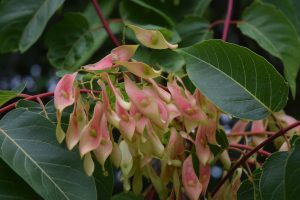
Tree-of-Heaven is easily confused with some of our native species that have compound leaves and numerous leaflets, such as sumacs and walnuts. The leaf edges of these native trees all have teeth, called serrations, while those of Tree-of-Heaven are smooth. The foul odor produced by the crushed foliage and broken twigs is also unique to Tree-of-Heaven.
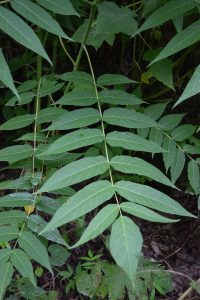
The only known insect to feed on Tree-of-Heaven is the Spotted Lanternfly (Lycorma delicatula), a native of China which was first detected in Pennsylvania in September 2014. According to the Illinois Department of Agriculture, Spotted lanternfly feeds on a wide range of fruit, ornamental and woody trees, with tree-of-heaven being one of the preferred hosts. Spotted lanternflies are invasive and can be spread long distances by people who move infested material or items containing egg masses. If allowed to spread in the United States, this pest could seriously impact the country’s grape, orchard, and logging industries. Fortunately, this insect has not yet been found in Illinois. For more information on the Spotted lanternfly, please visit: https://ilpestsurvey.inhs.illinois.edu/pest-information/most-unwanted/.
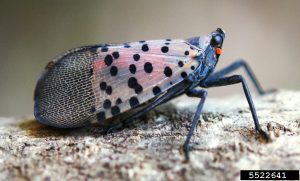
Tree-of-heaven can affect human health. The tree is a very high pollen producer and a moderate source of allergy in some people. In addition, a few cases of skin irritation or dermatitis have been reported from contact with plant parts (leaves, branches, seeds, and bark) and products. Symptoms often vary and depend on several factors, including the sensitivity of the individual, the extent of contact, and the condition of the plant or plant product. There are rare reports of myocarditis (inflammation of the heart muscle) from exposure to sap through broken skin, blisters, or cuts. People who have extensive contact with the tree should wear protective clothing and gloves and be careful to avoid contact with the sap.
For information on control and management, please visit Clifftop’s website: http://www.clifftopalliance.org/2011/08/tree-of-heaven/.
Clifftop’s events for July have been cancelled due to the Covid-19 pandemic. It is yet to be determined whether to hold the events scheduled for the remainder of the year. Please watch the upcoming events portion of this website and our Facebook page for updates.
If you would like to contribute to the Illinois Clean Energy Community Foundation (ICECF) Community Stewardship Challenge Grant for White Rock Nature Preserve and Land & Water Reserve that Clifftop was awarded earlier this year, monetarily or through volunteer work, please contact Joann Fricke at 618-935-2542 or cliffmbr@htc.net. For each dollar contribution we receive, ICECF will match 3:1, up to a total payment of $21,000 from the Foundation. And for 400 hours of volunteer stewardship, the Foundation will donate $4,000.
CLIFFTOP, a local nonprofit organization, is focused on preserving and protecting area bluff lands.
A version of this article appeared in the July 17, 2020 edition of the Monroe County Independent.
©2020 all content rights reserved Clifftop NFP.
Comments are currently closed.
